We’d like to share some impressions from the filling and blessing of the beautiful Buddha statues in our London Buddhist Centre. The filling took place back in February (19-21) 2010 when we had the privilege to host our great friends from Germany – Dagmar, Steffi and Sebastian – who are trained in the traditional art of statue filling. The statues are of Loving Eyes (Tib.Chenrezig), Diamond Mind (Tib. Dorje Sempa), and Green Liberatrice (Skt. Tara), as well as one of the 16th Karmapa holding the Black Crown.
Update: Check out the Beaufoy blog if you’d like to learn about the new Buddha statue in the London centre.
According to the Tibetan Buddhist tradition, Buddha statues are filled in a particular way with precious items and then blessed by a qualified lama so that the ultimate awareness of the Buddha is invited to enter in and merge with the statues. In this way, Buddha statues become like a living entity capable of giving blessing. Filling statues is therefore a very meaningful activity. It is said that by filling statues we create the cause to become ‘filled’ with realizations ourselves. The process of having a statue filled connects one to the Buddha represented by the statue. There are great benefits for the body, speech and mind in filling a statue. Filling it completes the body, speech and mind of the Buddha by helping to transform how we see the statue.
During the Four Foundational Practices (Tib. Ngöndro), for example Taking Refuge and Developing the Enlightened Attitude and Diamond Mind Meditation we purify our own body, speech and mind so that we become vessels for the blessing of our transmission lineage. The same principle applies to Buddha statues – we clean the inside of impurites from the casting process, to prepare it for the blessing. The enlightened body is represented by the statue itself, not simply an image of the Buddha but an expression of the qualities and levels of realisation. Specially prepared rolls of printed mantras placed inside the statue represent the blessing of enlightened speech. Finally when the statue is blessed by a qualified lama, this represents the blessing of enlightened mind. When we meditate on the statue we therefore mediate on the body, speech and mind of a Buddha.
The ways of filling statues are specific to each authentic Tibetan Buddhist lineage, and whether a Buddha statue is filled or not depends on the view of the level of Buddha’s teachings being practiced. For example in Theravada Buddhism, practitioners do not fill statues as they see them as outer forms only. In Diamond Way (Skt. Vajrayana) the filling of Buddha statues reflects the way we see the Buddha.
Traditionally it was mainly lamas (and therefore men) who filled statues. From 1996 the members of the Diamond Way Sangha, mainly from Germany, started receiving the transmission about the statue filling process from Lama Teunzang (from Montchardon in France). This learning process started slowly as it took time to make all the necessary mantras available for printing, to acquire knowledge about how to effectively clean the inside of the statues, and generally to understand the intricate details of the filing process. Currently Trehor Lama (from the Karmapa Buddhist Institute in Nice, France) helps to keep the Karma Kagyu transmission of statue filling in the West. This transmission is based on a text by Jamgon Kongtrul Lodro Thaye (1813-1899).
In Diamond Way Buddhist Centres, we participate in the filling process by preparing mantra rolls, cleaning the insides of the statues and then assisting the experienced friends who are trained in conducting this activity. It is an effective way to gather positive imprints in our minds. The preparations for this activity started in our London Buddhist Centre back in November 2009.
Firstly the sheets of mantras were printed and dyed with saffron water (which has preservative qualities) and afterwards a group of Sangha friends cut the mantra sheets into strips and rolled them into various sizes. While mantras were being rolled another group of friends cleaned the inside of our statues. This is the most challenging task in the preparation stage. The inside of the statue needs to be as clean and shiny as its outside surface and some areas are very hard to gain access to. Lots of time, patience and commitment is required to complete the task. All these activities were conducted during weekends and late evenings. Giving one’s time towards the statue filling process is the most precious offering. Also a very important thing about the process is to work and meditate together, build friendship and activity in the centre, and to have fun! (click on thumbnails to enlarge).
With generosity and help from everyone, the raw materials required for the filling had been gathered, such as sandalwood powder, relics, precious and semi-precious stones and other beautiful items like rose petals, lavender and dried flowers which were later used together with the mantras to fill the inside of the statues.
During the Friday afternoon and all of the Saturday, while the inside of the statues were coated with a special paint and were drying out, our Sangha friends made the last mantra rolls, prepared the relics and the “life tree” for each statue, cut wooden bases to support the bottom of the statues’ lotus flowers and got involved in many other activities to ensure the actual filling planned for Sunday would go smoothly.
On the Sunday morning everyone gathered in the meditation room of our London Buddhist Centre. While the first lotus was being filled and everyone was invited to contribute there was an amazing blessing and much excitement. Among the various important relics placed inside the statues were:
Substances blessed by Kagyu lamas in various initiations:
- 17th Karmapa Trinley Thaye Dorje: White Umbrella (Tib. Dukar) (Hamburg, June 2007); Almighty Ocean (Tib. Gyalwa Gyamtso) (Kassel, August 2007); White Liberatrice (Skt. Tara) ( London, June 2007); Guru Rinpoche (Graz, March 2009)
- Shamar Rinpoche: Buddha of Limitless Light (Tib. Opame) (Kassel, 2006)
- Lopön Tsechu Rinpoche: Wheel of Time (Skt. Kalachakra) (Karma Guen, 1994)
- Sherab Gyalsten Rinpoche: Loving Eyes (Tib. Chenrezig) (Hamburg, June 2007)
From stupas:
Bodhgaya, Kushinagar, Ajata Shraku Stupa (Rajgir), Sujata Stupa (Bodhgaya), Swayambu Stupa (Kathmandu); Pharamarajika Stupa (Sarnath), Shariputra Stupa (Nalanda), Shravasti Stupa of Miracles, Vaishah Stupa, and pieces of wood from the Life Tree of the Stupa of Enlightenment (Benalmadena, Spain).
From holy places:
Earth from Sarnath and Rajgir, Bodhi Tree leaf (Bodghaya), Bodhi Tree leaf (Lumbini), earth from the meditation caves of Naropa and Milarepa.
Other items:
A bessing string from the 16th Karmapa, pills based on relics from Naropa, Marpa, Milarepa and Atisha, “mani pills” based on relics of the Third Karmapa Rangjung Dorje (given by Sherab Gyaltsen Rinpoche), blessed amber from Sherab Gyaltsen Rinpoche, protection strings blessed by the 17th Karmapa Trinley Thaye Dorje (specifically for statues belonging to Diamond Way Buddhist centres), and pieces of robe from the famous Buddha statue in the Boghgaya stupa.
The collective work and joyful effort that went into the process really brought our friendship even closer. Click on the thumbnails below to enlarge.
The final part of the process took place at the first opportunity we had for the statues to be blessed. This was during Lama Ole Nydahl’s recent visit to the UK. On 22 September 2010, before going on to the meeting with the UK sangha, Lama Ole found a moment to bless the statues, thus inviting the ultimate awareness of the Buddha to enter in and merge with the statues – activating them as authentic supports for meditation practice. A friend in London captured this blessing on his iPhone, see the video below:
In the video Lama Ole suggests that the Buddhas’ eyes are “opened” (another special process which involves painting the statues’ eyes). This will be the final touch, and we aim to do this soon!
Other posts which may be of interest :
Tags: 16th Karmapa, Diamond Mind, Green Tara, Jamgon Kongtrul Lodro Thaye, Loving Eyes, statue filling
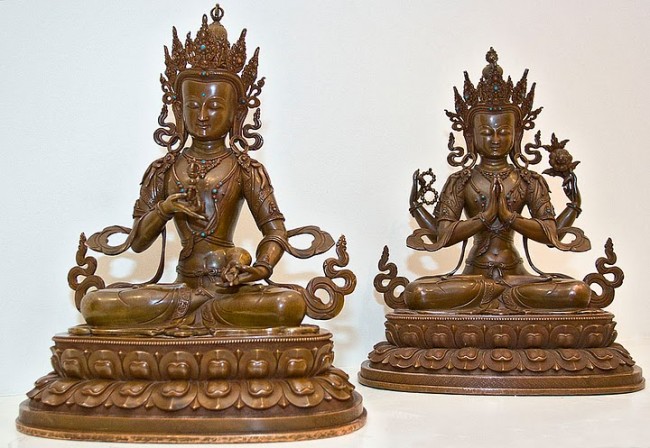
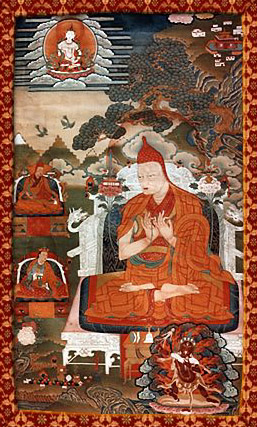

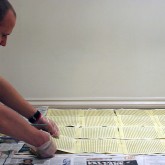
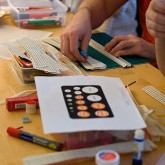
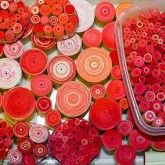
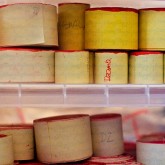

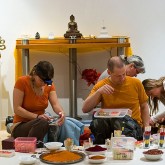

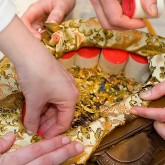
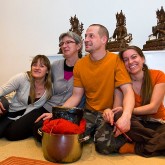
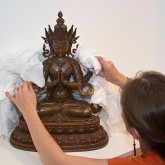
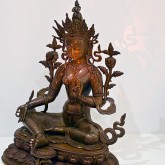

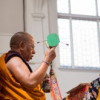

 Follow
Follow
[…] is a very informative post on the process of image blessing and statue filling. Follow the link for more photos and a video.- Buddhist art […]
The statues looks nice. An overwhelming feeling that statues are designed perfectly.